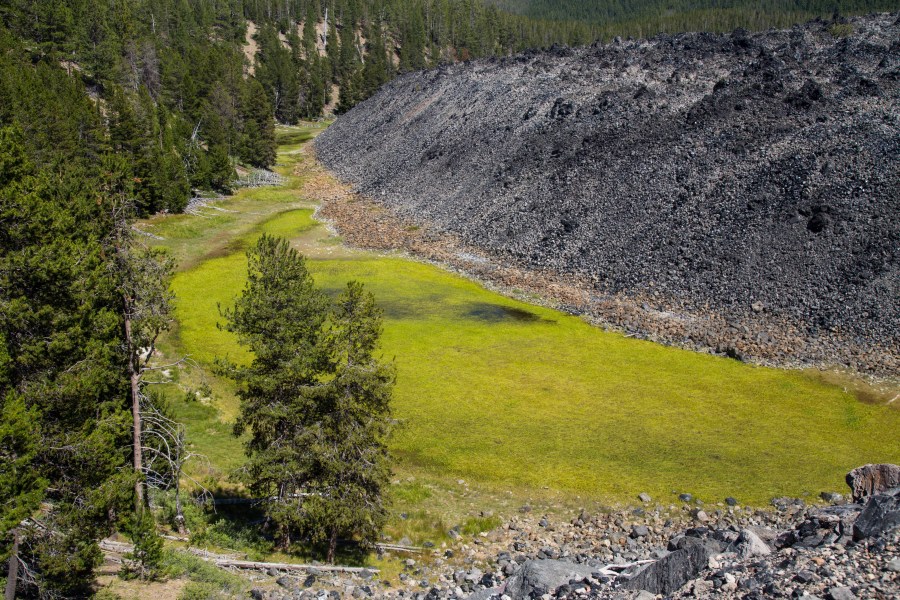We have just wrapped up a few days in the Deschutes National Forest in western Oregon, perhaps an hour drive west and south of Bend. I know I sound like a broken record, but two words describe this place: pretty freaking cool. Freaking is not a word, I think we all know that.
Deschutes National Forest has a lot of interesting places; of those we have seen I will mention, but there is much more. The forest sits in the Cascade Range, which is actually a volcanic range of mountains that begins at Lassen Peak (northern CA), through Crater Lake and extends into Canada. Unlike our time in Bend, we had pretty nice (perfect) weather.

First, where did we stay? Well, that would be the Lava Lake Resort and Campground! Queue music: The Time of Your Life.

No, no dirty dancing here, but that was kind of how I felt about this campground. It was on a beautiful lake (Lava Lake, wouldn’t you know), a rustic, cozy atmosphere, and a small store where you felt like you could have bought penny candy. Maybe you could.





I believe in this case the term “resort” means you get electricity and water, or maybe it is because they have a washer and dryer you can use. Whatever, it worked perfect for our needs with a full hookup site.
Oh, and Dottie was smitten because there was a chipmunk hole right in our campsite. It didn’t matter that deer came into our site; she remained focused on the chipmunks.







The campground was located a short distance off the Cascade Lakes Highway, which is just a stunning road with beautiful mountain, volcano remains, and gorgeous lake views. This area is clearly an outsiders’ paradise, with many hiking trails, kayak/canoe opportunities, fishing, snowmobiling, cross-country and downhill skiing. If you can do it outside, this is where you want to be.




We had driven into Bend previously and had noted the Newberry Volcanic National Monument. So while here in the Cascade Lake region, we visited. Wow! Approximately 7,000 years ago there had been a series of volcanic activity with volcano creation and resulting lava flows. This monument is a testimony to that time.


What was particularly interesting was some of its history. Mount Mazama (Crater Lake now) erupted about 7,700 years ago, and the ash and fallout from Mazama created between 3-6 feet of ash all around this area, and as a result of that ash created a fertile ground for trees to grow around Newberry. The trees are dense here, with the exception of where the lava flow came out of the Newberry eruption.




Right nearby you can actually go inside a lava flow, or lava cave. You may or may not know how much I like caves (hate), but I decided for the sake of a picture or two and a good story (you know, to say I had actually been in a cave), this was the time. Pretty cool – literally.

While it was in the high 70’s or low 80’s outside, the inside temperature is around 42 degrees. And it goes for a mile! Mind you, we did not go for a mile. There are no lights in the cave like there are at Carlsbad Caverns, so you need a flashlight or a lantern to even see.


All part of this same monument is the Newberry Caldera (Lava Butte), which like Crater Lake has a lake (actually in this case two lakes, Paulina and East Lakes) that have formed since the volcano collapsed. I will say these lakes are pretty, but they have not enjoyed the reverence and preservation that Crater Lake has enjoyed. There are campgrounds right on the edge of the lakes and the lakes are open to boaters.


As part of the caldera is a lava flow that is truly amazing. Known as the Big Obsidian Flow, you can hike up into it and be amazed at this powerful work of nature. If you are in this area, you definitely want to check this out!

The trail is essentially a trail on broken glass. Think of it this way: 73% of the rocks (Obsidian and Pumice) you see here are silica. Glass is made of silica. Hence…



Approximately 1,300 years ago (central Oregon’s most recent eruption), when the earth spewed another iteration of amazing, this mountain of rock was expelled from below the surface and sits here like some incredible mountain of rock and glass.

Its size is just staggering, although not able to be captured by photo (by me). It is a mile long, 150 feet in thickness (about a 17 story building), and the overall area of 640 football fields. This bad boy is big!






It is interesting to note that Obsidian has been highly valued. Native Indians used Obsidian for its strength and sharpness to create tools – including arrowheads. In the 1960’s, NASA came to the Big Obsidian Flow, heated it to enormous temperatures, and because the Obsidian contains water, extracted drinking water; all part of a strategy for survival on the moon. And in the 1970’s, doctors performed open-heart surgery on a patient using both steel and Obsidian scalpels. The incisions made using Obsidian left hardly any residual mark, while the steel scalpels left huge scars. Obsidian blades can be shaped so thin that they are about a molecule wide. Whoa; that’s thinner than my conscience.
I hate when I visit these places and learn how much I don’t know! The more I learn, it becomes evident – the less I know!
I once learned many years ago there are three bodies of knowledge: What you know (miniscule), what you know you don’t know (only slightly larger), and what you don’t know you don’t know (everything else).
Every day I am amazed as I learn what I don’t know I don’t know.
